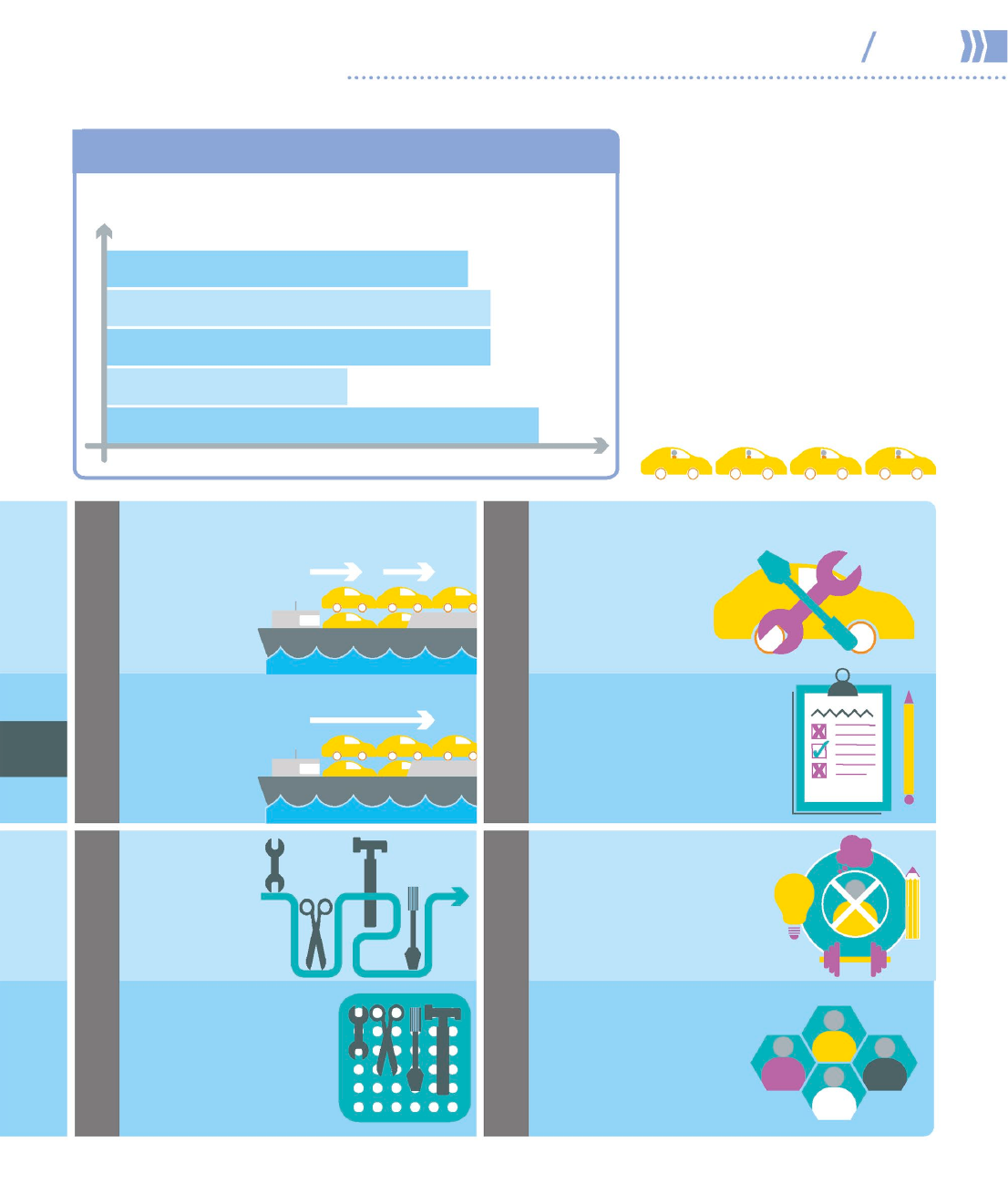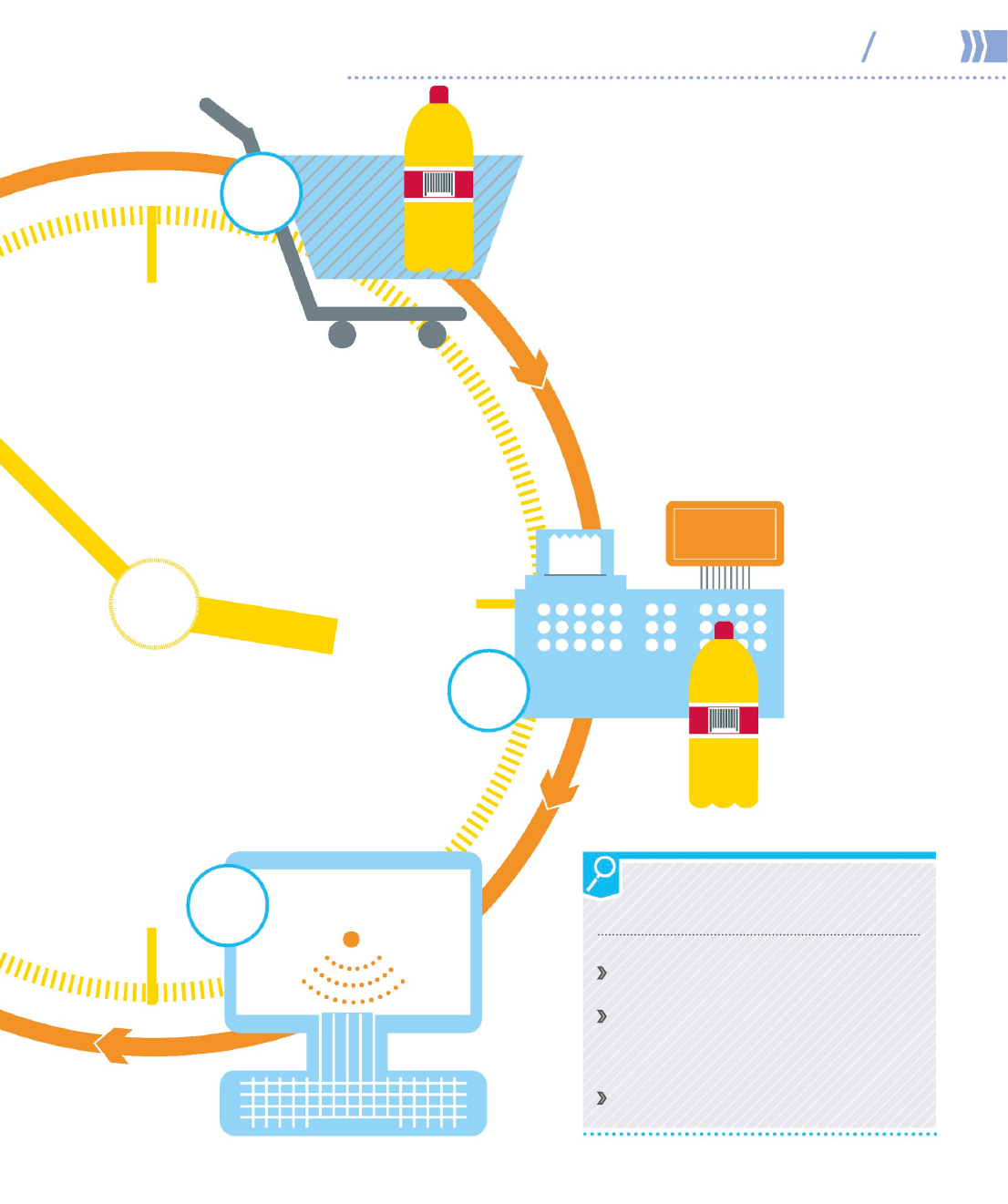
288 289
how operations and production work
Management
According to a US National Institute of Standards and Technology survey,
40 firms implementing lean production reported these benefits:
BENEFITS OF LEAN PRODUCTION
Waste
Superfluous
stages in the
transportation
process
Lean solution
Material shipped
directly from the
vendor to the
assembly line
Waste
Poor workflow,
poor layout,
and inconsistent
working methods
Lean solution
Workplace Organization,
a systematic method
for standardizing the
workplace
Waste
Underutilization of
employees’ mental,
creative, and physical skills
and abilities
Lean solution Work
cells replace assembly line;
better use of labor and
employee involvement
and communication
Waste
Unprofitable stages
in the production
or reworking of
a product
Lean solution
Map the value stream to
identify non-value-added
steps in the process; get it
right the first time
10
million
the number of cars
Toyota expected
to sell in 2014
Lead time (taking product from start to finish) reduced by 90%
Productivity increased by 50%
Work-in-process inventory reduced by 80%
Quality improved by 80%
Amount of space required reduced by 75%
A CB
Transportation in stages
Non-value-added processing
Excess motion
Underused people
A B
BENEFIT
PERCENTAGE
US_288-289_Lean_Production.indd 289 21/11/2014 16:28

How it works
Also called demand-pull production,
just-in-time means that stock levels
of raw materials, components, work
in progress, and finished goods are
kept as low as possible, reducing
costs. The system requires detailed
planning, scheduling, and flow
of resources throughout the
production process, now assisted
by sophisticated production-
scheduling software. Supplies
have to be delivered directly to
the production line when they
are needed, requiring strong
relationships and interconnected
systems with suppliers. The
benefits of reduced inventory
are balanced against the cost
Just-in-time
of frequent deliveries and loss of
purchasing economies of scale
(discounts for bulk buying). The
system dates back to 1953, the
year Toyota brought in just-in-time
manufacturing. The phrase is
sometimes used in a more general
sense today to mean eliminating
waste of resources.
The system of production in which an actual order is the trigger for
an item to be manufactured is called just-in-time. It enables a firm to
produce only the items required, in the right amount, at the right time.
just-in-time
pros and cons
Pros
Lower stock so less storage space
and less working capital needed
Demand-pull avoids obsolete,
out-of-date stock
Staff spend less time checking
and moving items
Cons
No room for error—for instance,
if there are any faults in the
stock delivered, the whole
day’s production is halted
Operation is reliant on suppliers
No cushion for sudden upsurge
in demand
SYSTEM
TRIGGERS
DELIVERY FROM
SUPPLIER WHEN
MINIMUM STOCK
LEVEL REACHED
NEW STOCK IS DELIVERED TO
STORE TO REFILL SHELVES
4
5
US_290-291_Just_in_time.indd 290 21/11/2014 16:28
290 291
HOW OPERATIONS AND PRODUCTION WORK
Management
$62
billion
the value of
Dell computers
sold in 2012
CUSTOMER
SELECTS
ITEM FROM
SHELF
COMPUTER SYSTEM
SIGNALS WAREHOUSE
Just-in-time in retail
To reduce stock levels, many supermarkets
now use just-in-time deliveries, relying on
computer data systems. In manufacturing,
systems are often based on Kanban cards—
dockets for withdrawing and ordering items at
each workstation of the production process.
CASHIER SCANS
BARCODE
1
2
3
Dell’s just-in-time computers
Computer produced when customer orders it:
Customer’s individual specification is sent
straight to factory floor.
Just in time manufacturing sees deliveries
of supplier parts arriving at one side of the
factory and unloaded directly into bins to
build customer order.
Inventory and costs are reduced.
Case study
US_290-291_Just_in_time.indd 291 21/11/2014 16:28

290 291
HOW OPERATIONS AND PRODUCTION WORK
Management
$62
billion
the value of
Dell computers
sold in 2012
CUSTOMER
SELECTS
ITEM FROM
SHELF
COMPUTER SYSTEM
SIGNALS WAREHOUSE
Just-in-time in retail
To reduce stock levels, many supermarkets
now use just-in-time deliveries, relying on
computer data systems. In manufacturing,
systems are often based on Kanban cards—
dockets for withdrawing and ordering items at
each workstation of the production process.
CASHIER SCANS
BARCODE
1
2
3
Dell’s just-in-time computers
Computer produced when customer orders it:
Customer’s individual specification is sent
straight to factory floor.
Just in time manufacturing sees deliveries
of supplier parts arriving at one side of the
factory and unloaded directly into bins to
build customer order.
Inventory and costs are reduced.
Case study
US_290-291_Just_in_time.indd 291 21/11/2014 16:28

WHAT TQM MEANS
How it works
Companies use TQM to create a
customer-focused organization
that involves all employees in
continuous improvement. It is a
strategic and systematic approach
that puts quality at the heart of the
organization’s activities and culture.
Customers determine the level of
quality, measured through their
satisfaction. The organization is
viewed as a series of horizontal
processes that take inputs from
suppliers through to the outputs
that are delivered to the customer.
Recording and measuring
performance data is critical, as
is effective communication to
maintain momentum.
Total Involves everyone and all
activities in the company
Quality Conformity to meeting
customer requirements
Management Quality can and
must be managed
Total quality
management
Case study: The Walt
Disney Company
Manufacturing companies, in which
the focus is on meeting or exceeding
customer expectations by making
products within certain specifications,
are often used as TQM examples. TQM
can also be applied in service industries,
of which Disney is a very good example.
“TQM is a
philosophy for
managing an
organization to
meet stakeholder
needs without
compromising
ethical values.”
Chartered Quality Institute
Success though customer satisfaction is the ethos of total quality
management (TQM). Everything a company does is relevant, and the
focus is on managing and improving processes rather than outcomes.
The Walt Disney
Company
Disney’s goal is to maximize
long-term shareholder value,
and part of this involves
delivering a magical customer
experience at its theme parks.
Involve everyone
in quality
Founder Walt Disney firmly
believed in quality and saw it
as everyone’s job, something
that could not be delegated.
Focus on the customer
Disney incorporated the
TQM concept of quality into
its approach to customer
service. Its visitors are seen
as
guests and treated as VIPs
and individuals.
Perfect processes
Walt Disney viewed the theme
parks as factories producing
delight. He built quality by
designing processes and
repeating them.
US_292-293_Total_Quality_Management.indd 292 21/11/2014 16:41
292 293
how operations and production work
Management
NEED TO KNOW
Suppliers
Disney collaborates with
suppliers—for example, it has
partnerships with McDonald’s
and Coca-Cola—to ensure
consistent quality.
Employees
Disney calls its employees
“cast members.” They are
trained in every aspect of
delivery, including posture,
gestures, facial expressions,
and tone of voice.
“When does the Three
O’Clock Parade start?”
Cast members are trained to
answer this common question
by responding with the time
the parade will be passing a
particular point in the park.
Continuous
improvement
Walt Disney saw the theme
parks as an incomplete
product; today, improvements
come from the bottom up.
Exceptional service
Cast members (employees)
are focused on delighting
the customer—their sole job
is to make visitors happy.
Shared purpose
Walt Disney started by
defining a company culture
based entirely on creating
a genuine shared purpose
that people would be proud
to support.
Integrated systems
Technology supports the
experience: for example, the
volume of ambient music is
the same in all theme parks,
delivered through thousands
of perfectly placed speakers.
American customer
satisfaction index (ACSI)
Cross-industry benchmarks for
customer satisfaction in the US;
NCSI is the UK equivalent
Net Promoter Score (NPS®)
Metric for company performance
from the perspective of customers,
who are divided into promoters,
passives, and detractors
12,000
Disneyland “cast members” are
employed to make guests happy
US_292-293_Total_Quality_Management.indd 293 21/11/2014 16:41

292 293
how operations and production work
Management
NEED TO KNOW
Suppliers
Disney collaborates with
suppliers—for example, it has
partnerships with McDonald’s
and Coca-Cola—to ensure
consistent quality.
Employees
Disney calls its employees
“cast members.” They are
trained in every aspect of
delivery, including posture,
gestures, facial expressions,
and tone of voice.
“When does the Three
O’Clock Parade start?”
Cast members are trained to
answer this common question
by responding with the time
the parade will be passing a
particular point in the park.
Continuous
improvement
Walt Disney saw the theme
parks as an incomplete
product; today, improvements
come from the bottom up.
Exceptional service
Cast members (employees)
are focused on delighting
the customer—their sole job
is to make visitors happy.
Shared purpose
Walt Disney started by
defining a company culture
based entirely on creating
a genuine shared purpose
that people would be proud
to support.
Integrated systems
Technology supports the
experience: for example, the
volume of ambient music is
the same in all theme parks,
delivered through thousands
of perfectly placed speakers.
American customer
satisfaction index (ACSI)
Cross-industry benchmarks for
customer satisfaction in the US;
NCSI is the UK equivalent
Net Promoter Score (NPS®)
Metric for company performance
from the perspective of customers,
who are divided into promoters,
passives, and detractors
12,000
Disneyland “cast members” are
employed to make guests happy
US_292-293_Total_Quality_Management.indd 293 21/11/2014 16:41
..................Content has been hidden....................
You can't read the all page of ebook, please click here login for view all page.
